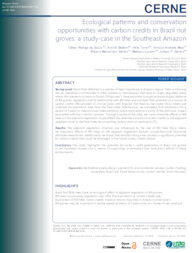Ecological patterns and conservation opportunities with carbon credits in Brazil nut groves: a study-case in the Southeast Amazon.
Ecological patterns and conservation opportunities with carbon credits in Brazil nut groves: a study-case in the Southeast Amazon.
Autoria: SOUZA, C. R. de; BALDONI, A. B.; TONINI, H.; MAIA, V. A.; SANTOS, R. M. dos; LUVISON, M.; SANTOS, J. P.
Resumo: BACKGROUND: Brazil Nuts (BN) tree is a species of high importance in Amazon region. Their continuous use by traditional communities is often related to disturbances that lead to larger degraded areas where this species is commonly found ("BN groves"). Here we aimed to explore the ecological patterns of BN groves vegetation and its relationship with BN trees and evaluate their potential as a source of carbon credits. We sampled 15 circular plots, with Brazilian Nut trees as the center (focal trees) and collected morphometric data from the focal trees. Additionally, we evaluated fruit production for a period of 5 years to obtain annual measurements, which were used as a proxy of the anthropic impact associated with the collection process. Through analysis of the data, we: i) examined the effects of BN trees on the adjacent vegetation; ii) quantified the potential amount of carbon credits in the adjacent vegetation and in the focal trees by converting carbon stock to equivalent CO2. RESULTS: The adjacent vegetation structure was influenced by the size of BN trees (focal trees). No important effects of BN trees on the adjacent vegetation floristic composition and functional attributes were found. Additionally, we found that Brazilian Nut groves possess a significant potential for carbon credits that could be leveraged in the future carbon credit market. CONCLUSION: The study highlights the potential for carbon credit generation in Brazil nut groves in the Southeast Amazon as a means of supporting conservation and restoration efforts in these environments.
Ano de publicação: 2023
Tipo de publicação: Artigo de periódico
Unidade: Embrapa Milho e Sorgo
Palavras-chave: Bioeconomia florestal, Biomassa florestal, Carbon trading, Castanha do Para, Mercado de carbono
Observações
1 - Por padrão são exibidas publicações dos últimos 20 anos. Para encontrar publicações mais antigas, configure o filtro ano de publicação, colocando o ano a partir do qual você deseja encontrar publicações. O filtro está na coluna da esquerda na busca acima.
2 - Para ler algumas publicações da Embrapa (apenas as que estão em formato ePub), é necessário ter, no celular ou computador, um desses softwares gratuitos. Sistemas Android: Google Play Livros; IOS: iBooks; Windows e Linux: software Calibre.
Acesse outras publicações
Acesse a Base de Dados da Pesquisa Agropecuária (BDPA) para consultar o acervo completo das bibliotecas da Embrapa.

